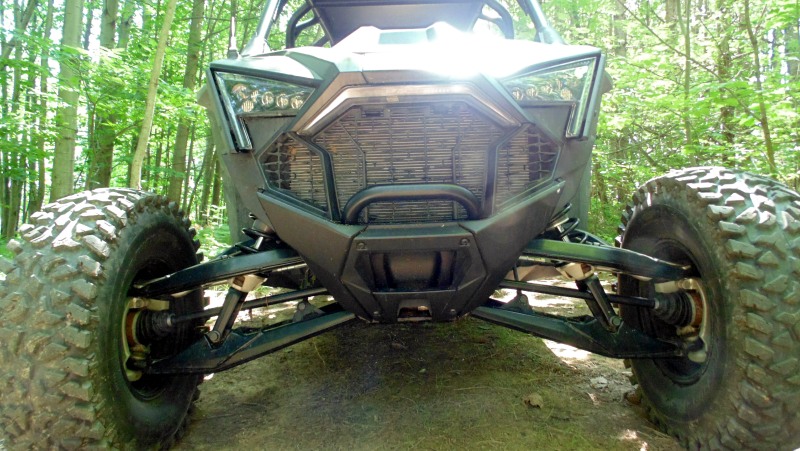Polaris RZR Pro R 4 Ultimate Review
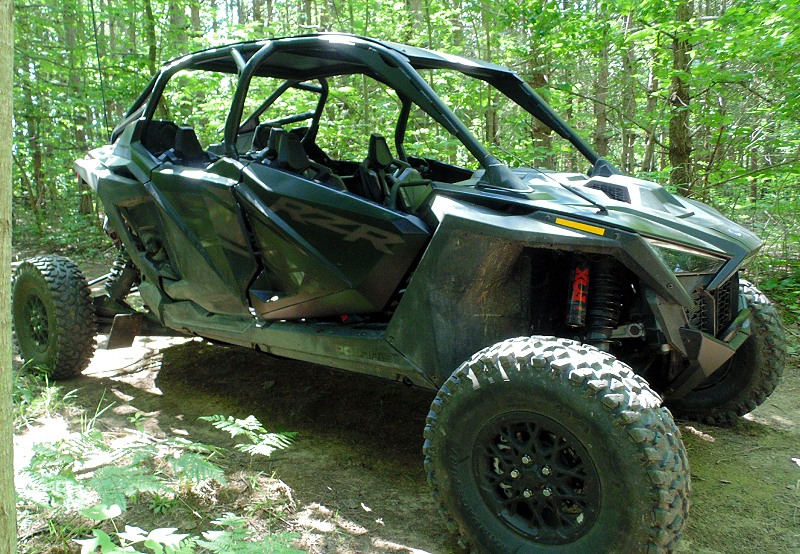
Built for the desert and a terror on the trails.
We humans like to push limits. We work to achieve a pedigree of performance in just about every conceivable arena then we do everything we can to topple the records we ourselves set with our achievements. This analogy applies perfectly to the Polaris RZR Pro.
We are no stranger to today’s breed of fire-breathing, big-bore 4-strokes and spend a fair deal of time turning soil into airborne dust but when the truck arrived carrying the 2023 Polaris RZR Pro R 4 Ultimate in stealth black trim, even the most boastful around here swallowed hard.
This is a machine that takes the former largest displacement SxS available in the world and doubles the displacement (2,000 cc). Not only that but it packs 29” of suspension travel via Fox’s revolutionary Live Valve 3.0 “Smart” shocks all the way around. Like you, we’ve seen pictures of them prior, read reviews, watched videos on Youtube, but there’s something about this machine up close and personal that no amount of research can prepare you for. It’s unapologetically big, wide, and it sounds every bit as mean as it looks. Even that only tells half the story. Sending it into motion is an immediate display in top-tier performance. Nothing about this machine is for the faint of heart – including its $44,999 MSRP.
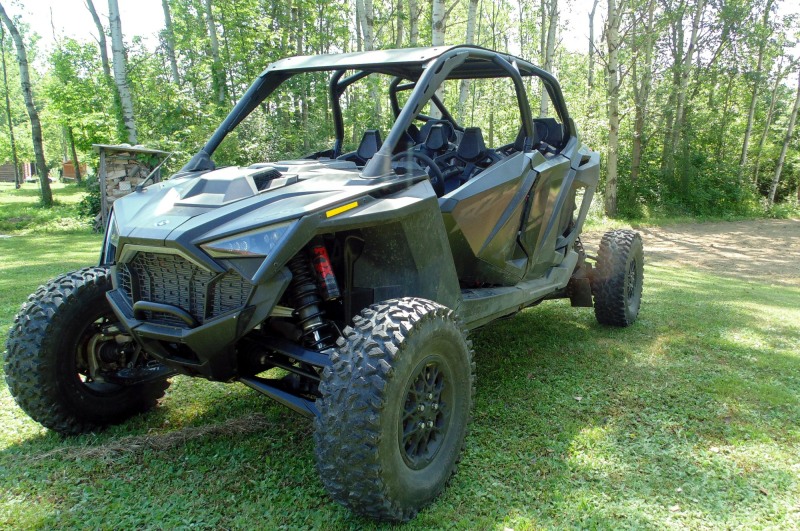
Throughout the past decade, side-by-sides have been steadily growing larger, beefier and faster but, as is tradition for human nature, the limits we’ve established have been pushed. The following review is the result of several months of exclusive testing across a variety of terrain ranging from high-speed hard pack to tight woodland trails, from slippery mud to endurocross style technical obstacle traversal. The real conclusion doesn’t come until the end of the review but we’ll give you a bonus conclusion right now to kick things off – the RZR Pro 4 Ultimate lives in a class of its own.
The Walkaround
We mentioned above that pics and spec sheets don’t really do this one justice and that’s apparent the moment you approach it. It tracks at nearly 75” wide, sits on 15” wheels/ 32” tires jutted well away from the chassis, and the shocks look like they were taken directly off an off-road race truck.
Rearward opening doors reveal a spacious and comfortable cab with stadium-style bucket seating, 6-point harness restraints, and rear seats that can actually be folded down, revealing tie down points for maximum storage. Even with the seats upright, there is a spacious cargo box in the rear over the engine.
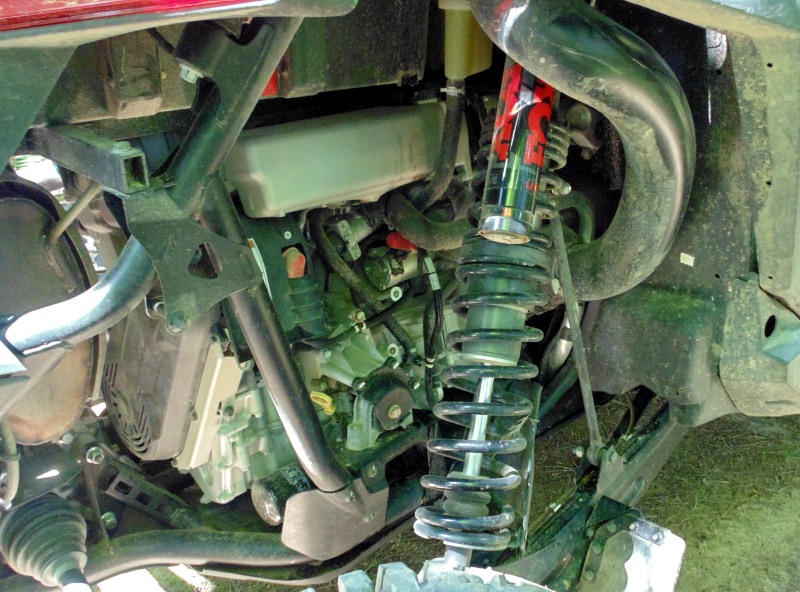
And oh that engine. 2-liter inline four cylinders may be commonplace on the asphalt, but it takes only a passing glance to realize this is new territory for UTVs. Then once that mill barks to life, churning all of its audible fury through its two into one exhaust, expectations are subverted again. You may have expected it to sound throaty or perhaps even more like the silky hiss of a track-tuned sportbike but the Pro R reminds you immediately that this machine is unlike anything else out there. It sounds like it looks and it looks like it came to change the speed of the Earth’s rotation.
And while it utilizes a fully automatic PVT transmission, Polaris packs it with a few switches’ worth of options to consider before blasting off into a place of blurring terrain, neck stretching acceleration and the kind of smiling that demands a full face helmet for fear of swallowing a swarm of bugs alone.
Options Galore
Deciding which gear you want is a simple matter of using the center-mounted shifter, which offers both a High and Low range forward option, with your chosen selection appearing on the driver-side dash LCD display. A switch on the upper left portion of the driver-side dash allows for selection of 2WD/4WD/ or 4WD Lock. A switch to the right of the steering wheel offers three specific throttle settings: Sport, Rock and Race. Then there is the suspension – which can be set to Comfort, Race, Rock and Baja mode. Sure, you could bypass a lot of this and simply slide the shifter into H for high and push the accelerator with your right foot but getting the most of the experience is definitely worth a few moments of time spent assessing the terrain ahead and the speeds you’re hoping to achieve while conquering it.
Power Hour
Any machine good for 225 horsepower out of the box and known around the industry for pushing an actual G of acceleration upon its occupants at launch is surely going to be quick but rationalizing the endless pull of the RZR Pro 4 almost has to be experienced to be fully believed. It becomes immediately clear that this package will be most at home in the desert where near limitless space, steep hills and power-sapping sand all require massive power. Here on the Upper East Coast, deserts are a pretty rare commodity so, while we can’t get in depth on the best dune setup, we certainly speak thoroughly on what it feels like to dominate giant overgrown fields, tight trails cutting through the woods, climbing out of creek beds and popping up over fallen trees and boulders – in a word: Effortlessly.
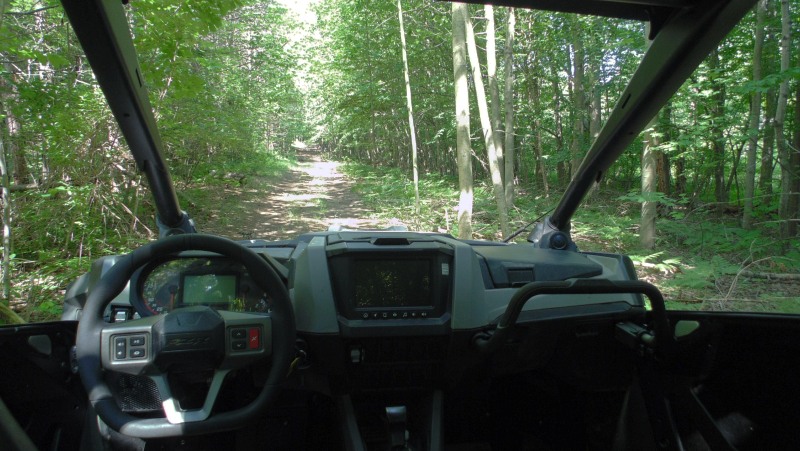
That DOHC inline, 16-valve four cylinder makes ridiculous amounts of power. As in the limitations of real estate, nerves or some combination of the two will always be reached before the RZR Pro stops pulling. We did a lot of our testing in mid-summer dry hardpack so 2WD, sport mode was our default setting a lot of the time and typically this type of power all being channeled to the rear-wheels usually results in a machine that simply stays put while digging itself closer to the center of the planet. Not this one! The Pro R hooks up way better than it has any right to. In even our most careless throttle applications, we continually came away with the RZR’s ability to put the power to the ground and go. No wildly spinning rear end or unintentional doughnuts here – when you push the pedal down on the Pro, the terrain starts to rush toward you. Quickly. How long you decide to hold it there and play chicken with that row of trees on the far side of the field that are approaching like a bullet is entirely up to you.
What About in the Low?
We can go on all day about how fast this thing is – it is really that remarkable, but for many interested parties, the question isn’t one about simply stretching their neck muscles around every corner but how the machine works in slower speed, technical terrain. Here the RZR Pro R is a bit of a conundrum. On the one hand that abundance of power and variety of modes to draw from really makes this a UTV that doesn’t flinch no matter what you throw at it. We ought to know; at one point in our testing we approached a felled tree several feet in diameter, large enough where the 1000cc ATVs we ride with typically have to detour so as not to get hung up on the frame. We flipped the switch to 4WD and moved the shifter to low and applied a little even throttle in experimentation. To our surprise, the RZR hopped over it as effortlessly as if it had been a stick. 29” of travel and 16” of clearance led us to experimenting with various steep grades, boulder crossings and trail clutter. We couldn’t once slow it down, make it demand a second approach or even get the wheels to break free and spin. It takes a lot to impress us around here but there wasn’t a single test ride that didn’t end in disbelief by all involved.
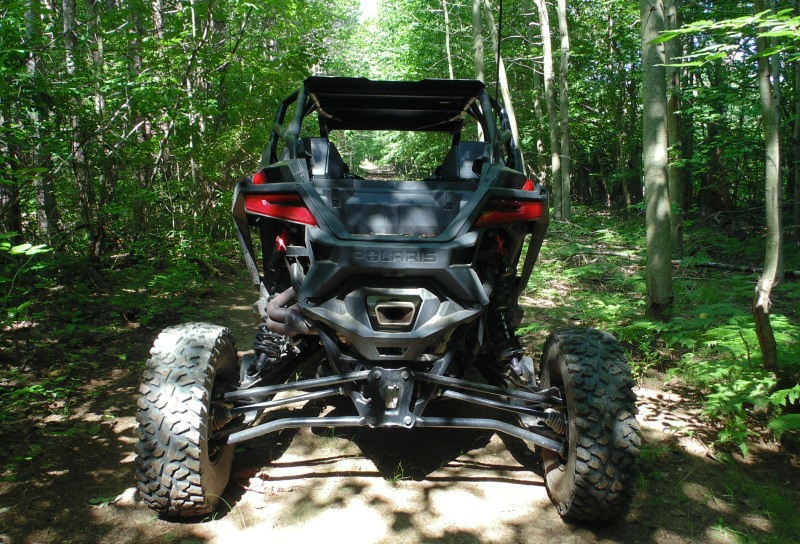
So a great trail machine too, then? Not exactly. The off-road world is all about compromise. To have a roomy interior you need a larger chassis and a larger chassis takes up more room on the tails. To have the type of power to climb a near vertical rock face means a lot of acceleration to manage in the tight stuff. It’s by no means impossible, but you favor tight, techy trails with switchbacks, this probably shouldn’t be your first choice. It’s wide, it’s heavy, it can be a handful and it sucks gas like a top-fuel dragster. We were able to reach 11 MPG by taking it easy in 2WD but get a little trigger-happy with all of that power on tap and you can watch the gauge fall. Additionally, while it is truly one of the most stable platforms we’ve ever experienced off-road, it comes at the cost of a very wide turning radius. On more than one occasion we had to come to a stop and Y-turn at trail intersections.
Handling
All of the power in the world is useless if it can’t be controlled. Polaris gets it. They did what we would have considered impossible prior to testing with the Pro R 4 – they developed a chassis capable of maximizing the potency of the engine. In fact, given the performance on tap here, simply controlling it would have been an accomplishment but they managed to come up with a package that actually makes it usable in every situation we threw at it.
We talk about this often in our reviews and the same principle applies here. To capitalize on performance, the frame needs to be stiff. To accomplish this Polaris created an all new chassis consisting of a single-piece welded cage consisting of 2” tubing and tapered joints where it mates with the chassis. Polaris claims that this alone has netted a 2X increase in torsional stiffness over prior designs.
Ordinarily a stiff frame and ultra-power engine mean a ride that could rattle out fillings but here’s where that Fox suspension comes into play. Polaris had the luxury of building the stiffest chassis they could without fear of compromising handling, control or even rider comfort. Utilizing the latest incarnation of DYNAMIX (the all new DYNAMIX DV), the RZR boasts sensors at each shock linked to an onboard computer continuously adjust the shocks on the fly, so the suspension is always at the optimal setting to maintain vehicle stability and deliver razor (no pun intended) sharp handling through the roughest terrain.
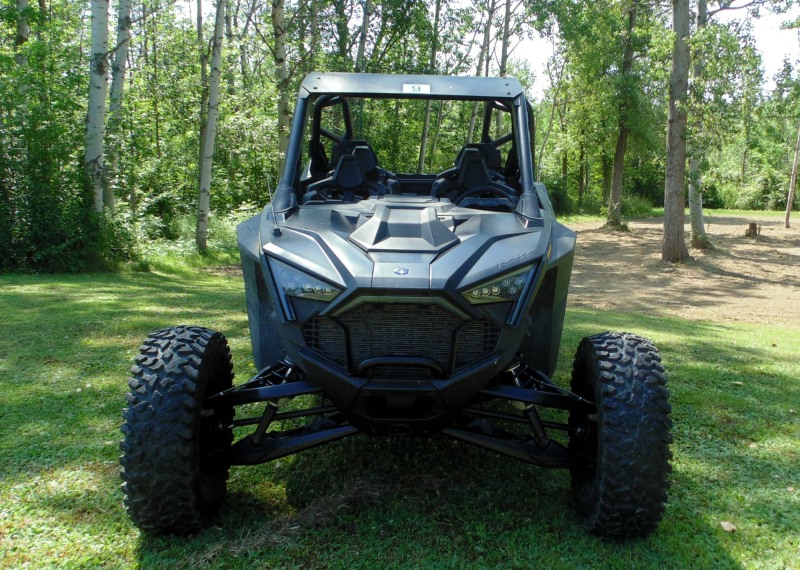
We’ve covered this technology in the past and while we’ve been very familiar with how it works, feeling it in action is something else entirely. The machine never feels like it’s fighting the driver, even under loads that send lesser machines pushing or rolling. We spent a lot of our testing pushing 70mph across choppy straight aways that demanded hard braking into 90-degree corners and came away astonished at the effectiveness of the DYNAMIX package. Successive chop, off-cambers, rollers and even whoops are swallowed up by those massive Fox 3.0 Live Valve X2 Shox as if the machine was set up for the racetrack then, as just as quickly, the suspension adjusts to limit roll when diving into a steep corner.
Reading and adjusting both the compression and rebound independently at a ridiculous 200 times per second, there is a screen on the RIDE COMMAND center that displays each of the four shocks and how they are being tweaked in real-time. This isn’t just a tech display, however, as it stabilization you’ll feel every time you get in over your head. A few riders commented that it felt like the RZR was floating above the terrain rather than getting beaten up by it. Given the type of rear end squat you’d expect to accompany this type of acceleration, we went into this review convinced it would take some engineering magic indeed to tame this engine. Upon completion, we’re just about as impressed with the chassis and suspension as we are the fire-breathing powerplant it carries. This is one of those rare machines that handles every bit as well as it performs and it outperforms just about every expectation.
Stepping Down
You often hear it said any vehicle is only as fast as it can stop and the RZR Pro R has some serious stopping power to call upon. We were surprised to discover the unit isn’t equipped with Polaris’s Engine Braking System (EBS), which essentially feeds natural engine compression to the wheels to keep from “free-wheeling” when you ease off the throttle. Amazingly, we didn’t miss it nearly as much as anticipated. Chalk it up to that PVT transmission, which seems to always offer the correct “gear” ratio and brakes with some serious stopping power in the form of 4-wheel hydraulic disc/ triple-bore front and dual-bore rear calipers with aluminum top hat rotors
The setup is certainly designed to scrub momentum in a hurry but we have to speak on the silky smooth modulation that always keeps the big RZR feeling in control. Such is the nature of East Coast trails, our testing rarely enjoyed wide-open scenarios and instead involved bursts of speed followed by hard braking into tight corners, repeat. It surely sounds like hyperbole but even after those 70mph pulls leading into 90-degree flat turns mentioned above, we never once blew a corner in the RZR.
Odds and Ends
Given this UTV’s position in the RZR hierarchy, you can be assured it contains all of the bells and whistles that the company offers. Among these, RIDE COMMAND 7” Glove-Touch Display: Built-In GPS, Mapping, Vehicle-to-Vehicle with Group Ride, Follow the Leader, & Messaging. Bluetooth & USB Smartphone Connectivity, AM/FM & Weather Radio, In-Vehicle Communications Capability. Rockford Fosgate Premium Audio (including 2 tweeters, and 2 front speakers, and external 400W amp).
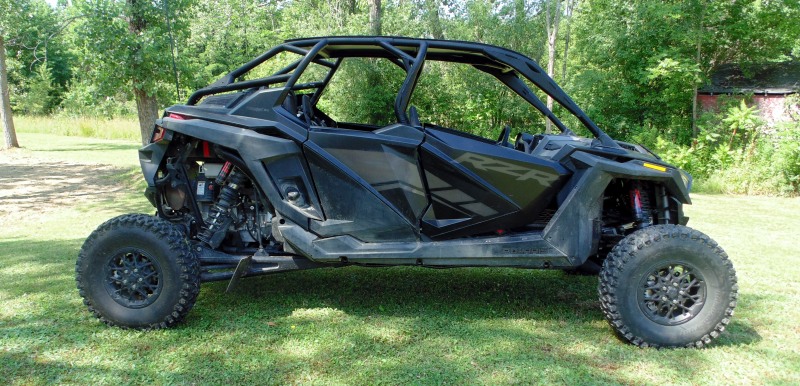
High output external 1700W alternator, Polaris Pulse System (in-dash charge port, 1 front DC accy ports, 1 rear DC accy port), Polaris P.A.S.S. anti-theft PIN # system, color backup camera with night vision, painted aluminum roof, hood scoop, factory mud and rock guards.
Truthfully we could spend this entire article just going over the goodies Polaris packs in as standard features on the Ultimate trim but instead we’ll just say RIDE COMMAND manages to dazzle with every iteration and that audio system leaves nothing to be desired.
Conclusion
The 2023 Polaris RZR Pro R 4 is a machine quite unlike any we’ve encountered and that’s saying a lot. Its spec sheets read like a dream, it looks like one nasty customer in pics, sounds like one in videos and wears a price tag that puts it in a place where news of owning one quickly spreads through the entire community. Even in communities of neighboring states.
We knew all of this going into the review but even so, felt unprepared for the sheer beastliness exuding from it up close and personal. It’s bigger than it looks in pictures, wider, beefier and a whole lot meaner. Turning the key results in a roar that will turn heads even from afar and stomping on the throttle once underway will silence even the rowdiest of passengers. We came up with a saying around here that sounds like marketing hyperbole but it really isn’t – The Polaris RZR Pro R isn’t a machine, it’s an experience.

It isn’t cheap, but this is upper echelon performance that truly finds itself in a class of its own. In fact, until Can-Am’s recently announced 2024 Maverick R, the Polaris RZR Pro R was literally in a class all by itself. The RZR Pro R going full-tilt offers acceleration that is addicting as any narcotic; the siren song to the driver’s right foot even when he knows liberal application will make the fuel gauge drop before his eyes and exponentially shorten the life of his tires. It’s truly one of those rare sensory overload situations that you find yourself thinking back to with a grin during work meetings, gets you out of bed early on riding days and, when you start to think you’re used to it, makes you jump right as you’re drifting off to sleep at night.
Specs
ENGINE & DRIVETRAIN
Cooling
Liquid
Cylinders Displacement
1997cc
Drive System Type
Pro Performance True 2WD/4WD/4WD Lock
Engine Braking System (EBS)
Not Equipped
Engine Type
4-Stroke DOHC Inline Four Cylinder
Fuel System/Battery
Electronic Fuel Injection
Horsepower: 225 HP
Transmission/Final Drive
Automatic PVT P/R/N/L/H
DIMENSIONS
Bed Box Dimensions (L x W x H)
29.5 x 23.8 x 8.1 in (75 x 60.5 x 20.6 cm)
Box Capacity
300 lb (136 kg)
Estimated Dry Weight
2,480 lbs (1,124.91 kg)
Fuel Capacity
12.30 gal (46.56 L)
Ground Clearance
16 in (40.6 cm)
Overall Vehicle Size (L x W x H)
165.5 x 74 x 76.5″ (420 x 188 x 194 cm)
Payload Capacity
900 lb (408 kg)
Wheelbase
133.5 in (339.1cm)
BRAKES
Front/Rear Brakes
4-Wheel Hydraulic Disc with Triple-Bore Front and Dual-Bore Rear Calipers; Aluminum Top Hat Rotor
Parking Brake
Park In-Transmission
ADDITIONAL SPECIFICATIONS
Cargo System
Lock & Ride; Convertible Fold Flat rear seat storage with integrated tie downs points, 27.7 x 52.8 x 19.5″ (70.4 x 134.1 x 49.53 cm) Factory Equipped Cargo Liner
Doors
Front & Rear Full Doors
Electronic Power Steering
Rack Mounted High Assist Electronic Power Steering with Quick Turn Rack; Race Inspired Steering Wheel with Tilt and Telescoping Adjustment; DYNAMIX DV with Integrated EPS Modes and Ride Command Push Button Controls
Hitch Type: Not Equipped
Instrumentation
RIDE COMMAND 7” Glove-Touch Display: Built-In GPS, Mapping, Vehicle-to-Vehicle with *Group Ride, Follow the Leader, & Messaging. Bluetooth & USB Smartphone Connectivity, AM/FM & Weather Radio, In-Vehicle Communications Capable With Optional Sena Headsets, Rockford Fosgate Premium Audio (Including 2 Tweeters, and 2 Front Speakers, and External 400W Amp) Dual-sweep Analog Dials w/ 4 in LCD Rider Information Center: User Selectable Blue/Red Backlighting & Brightness, Programmable Service Intervals. Digital Instrumentation: Speedometer, Tachometer, Odometer, Tripmeter, Clock, Hour Meter, Gear Indicator, Fuel Gauge, Coolant Temperature, Voltmeter, Service Indicator and Codes, Seat Belt Reminder Light, Gear Indicator
Lighting
Signature White LED, Low/High & Red LED Tail / Brake Lights; Front, Rear, and Interior Accent Lighting
Other Standard Features
RIDE COMMAND, High Output External 1700W Alternator, Polaris Pulse System, In-Dash Charge Port, 1 front DC Accy ports, 1 rear DC Accy port, Polaris P.A.S.S., Painted Aluminum Roof, Colored Toe Link, Hood Scoop, Mud and Rock Guards, User Selectable Throttle Modes (Sport, Rock, & Race)
RIDE COMMAND+ Factory-Installed
Seat Type
Color-Matched, Front Bolstered Bucket Seats with 4-way adjustability (including 6″ front to back toolless seat sliders with tilt adjustability) and Retractable Click-6 Harnesses, Rear Stadium style seating with non-retractable 6-point harnesses
TIRES / WHEELS
Front Tires
32 x 10-15 Maxxis Rampage Fury; 8-Ply Rated; Wheel Size 15×7
Rear Tires
32 x 10-15 Maxxis Rampage Fury; 8-Ply Rated; Wheel Size 15×7
Wheels
Painted Cast Aluminum Rim with 5-Lug Pattern
SUSPENSION
Electronic Suspension Control System
Dynamix DV with Selectable Ride Modes: Comfort, Rock, Track, Baja
Front Shocks
FOX 3.0 Live Valve X2 Internal Bypass (Electronically Controlled Compression and Rebound)
Front Suspension
Light Weight Boxed Dual A-Arm with 3 piece Stabilizer Bar and 27.0″ (68.6 cm) Usable Travel, 22.25″ (56.5 cm) Wheel Travel, Unitized Hubs
Rear Shocks
FOX 3.0 Live Valve X2 Internal Bypass (Electronically Controlled Compression and Rebound)
Rear Suspension
Boxed Trailing Arm with Toe Link, High-Clearance Radius Rods, and 3 piece Stabilizer Bar and 29.0″ (73.7cm) Usable Travel, 24.5″ (62.2 cm) Wheel Travel, Unitized Hubs
More Information

